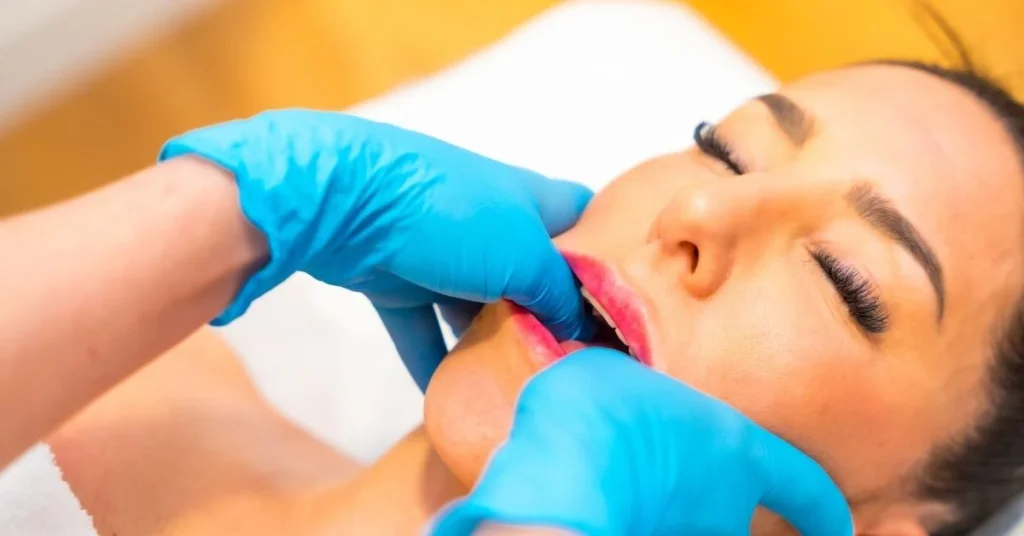
Jaw pain, trouble chewing, or frequent headaches may point to a temporomandibular joint TMJ disorder. These issues can make daily tasks like eating, speaking, or sleeping uncomfortable. This guide explains TMJ disorders in detail, covering their causes, symptoms, and treatment options. It focuses on how chiropractic care offers a natural, non-invasive way to manage jaw pain. Whether you’re new to TMJ issues or looking for drug-free solutions, you’ll find clear, evidence-based information here.
The guide breaks down the science behind TMJ, explores chiropractic techniques, and provides practical tips for relief. It’s written for everyone, from those experiencing mild discomfort to those with chronic symptoms.
By the end of this article, you’ll understand:
- How the temporomandibular joint works and why it causes pain.
- Common causes and symptoms of TMJ disorders and their impact on daily life.
- How chiropractic adjustments and therapies relieve jaw pain and related issues.
- What to expect during chiropractic treatment and how to prepare for it.
- Practical steps to choose a qualified chiropractor in Dalton, Georgia.
Defining TMJ Disorder
Clarifying TMJ and TMD Concepts
The temporomandibular joint (TMJ) links your lower jaw to your skull. It lets you chew, speak, and yawn. TMJ disorders, also called TMD, affect the joint, muscles, or tissues around it. These issues cause pain, limited movement, or noises like clicking when you move your jaw. If you notice these signs, chiropractic care may help by fixing alignment problems in your jaw or spine.
Distinguishing TMJ from TMD
TMJ refers to the jaw joint itself. TMD covers problems with the joint and nearby muscles or tissues. For simplicity, this guide uses TMJ disorder since it’s a common term in medical and casual settings.
Structure of the Temporomandibular Joint
Position and Components of the TMJ
The TMJ sits in front of your ears, connecting the lower jaw to the skull’s temporal bone. This joint acts like a hinge and a slide. A cartilage disc cushions it to prevent friction. Muscles like the masseter and temporalis, along with ligaments and nerves, help it move smoothly.
Functions in Jaw Motion and Activities
The TMJ allows you to open and close your mouth, move it side to side, and slide it forward or backward. These motions are vital for chewing, speaking, and swallowing. If the jaw, spine, or muscles are out of alignment, TMJ problems can develop. For example, a misaligned neck from poor posture might strain the jaw joint.
Scope and Effects of TMJ Disorders
About 5-12% of people worldwide have TMJ disorders, with women more affected due to hormonal factors. A 2021 study in the Journal of Oral Rehabilitation found symptoms are most common in adults aged 20-40, but children and adolescents or women during pregnancy can also experience them. Gentle chiropractic methods can help these groups. In the U.S., millions have jaw pain each year, often without a clear diagnosis.
Influence on Daily Activities and Health
Jaw pain can make eating hard, leading to poor nutrition or weight loss. Headaches, ear pain, or trouble sleeping can lower your energy and focus. For example, a teacher with TMJ might struggle to speak all day. If untreated, these issues can worsen posture or lead to stress and anxiety from constant discomfort.
Origins and Predisposing Factors of TMJ Disorder

Primary Causes of TMJ Dysfunction
TMJ disorders come from many sources, often mixing physical, behavioral, and health-related factors. Knowing these causes helps you decide if chiropractic fits your TMJ condition.
Trauma and Physical Injury
Physical trauma, like a hit to the jaw or whiplash from a car accident, can harm the TMJ’s cartilage or ligaments. Whiplash often shifts the cervical spine, which affects jaw movement. For instance, a rear-end collision might cause neck and jaw pain months later.
Bruxism and Jaw Clenching
Teeth grinding and clenching (bruxism) put extra stress on the TMJ. Often tied to stress, these habits wear down the joint’s cartilage and tire out muscles. Someone grinding their teeth at night might wake up with a sore jaw.
Postural and Spinal Issues
Poor posture or spinal misalignment in the neck changes how the jaw moves. Sitting hunched over a computer for hours can strain your neck and jaw. This might lead to TMJ pain over time.
Stress-Induced Muscle Tension
Stress tightens muscles in your jaw, neck, and shoulders. This muscle tension can limit TMJ movement, causing pain or clicking. For example, a stressful job might make you clench your jaw unconsciously.
Arthritic Conditions
Arthritis, like osteoarthritis or rheumatoid arthritis, wears down TMJ cartilage or causes inflammation. This leads to stiffness and pain, especially in older adults. A patient with arthritis might notice their jaw feels tight in the morning.
Dental Misalignments
Dental issues, such as a misaligned bite or overbite, put uneven pressure on the TMJ. This causes strain. Dentists focus on fixing bites, but chiropractors work on jaw realignment and spine issues. For example, a bad bite might make one side of your jaw work harder, leading to pain.
Genetic and Hormonal Influences
Genetic factors, like loose joints, raise TMJ disorder risk. Hormonal changes in women can weaken TMJ tissues, explaining why women are more prone to these issues. A young woman might notice worse symptoms during hormonal shifts.
Don’t let TMJ pain control your life. Take the first step towards a pain-free jaw today.
Factors Increasing TMJ Risk
Certain habits and jobs increase your chances of TMJ problems.
Habits and Dietary Choices
Chewing gum too much or eating hard foods like nuts strains the TMJ. This can cause inflammation or muscle tiredness. For instance, chewing tough candy daily might lead to jaw soreness.
Occupational Stressors
Occupational hazards, like long hours of talking or singing, stress the TMJ. Teachers or singers might feel jaw pain after a long day. A call center worker could also be at risk from constant talking.
Related Health Conditions
Associated conditions like fibromyalgia or sleep apnea make TMJ issues worse. Fibromyalgia causes widespread pain, and sleep apnea often involves jaw clenching, both adding to TMJ strain.
Signs and Symptoms of TMJ Disorder

Common Indicators of TMJ Issues
TMJ disorders show up in different ways, from mild to severe. Spotting these signs helps you decide if you should see a chiropractor for TMJ, especially if symptoms don’t go away.
Pain and Tenderness in the Jaw
Jaw pain and tenderness near the ears is a key TMJ sign. Pain often gets worse when you chew or talk. For example, eating a tough steak might make your jaw ache.
Jaw Sounds During Movement
Clicking, popping, or grating sounds in the jaw point to joint problems or a displaced disc. Chiropractic adjustments can realign the TMJ to quiet these noises. A clicking jaw when you yawn might be an early sign.
Restricted Jaw Motion and Locking
Limited jaw movement or locking makes eating or yawning hard. Chiropractic care can ease jaw clicking or locking by fixing joint alignment. Someone with a locked jaw might struggle to open their mouth wide.
Headaches and Migraine Pain
Headaches and migraines often come from TMJ-related muscle strain or nerve pressure. These might feel like tension in your temples.
Ear-Related Discomfort
Ear pain, ringing (tinnitus), or fullness happens because the TMJ is close to the ear canal. These symptoms can feel like an ear infection but stem from the jaw.
Facial Pain and Swelling
Facial pain and swelling around the jaw come from inflammation or muscle spasms. You might notice puffiness near your jawline after chewing.
Pain in Neck, Shoulders, and Back
Neck, shoulder, and upper back pain connect to TMJ through shared muscles and spinal alignment issues. A stiff neck might make your jaw feel worse.
Challenges with Chewing or Swallowing
Difficulty chewing or swallowing affects eating and comfort. Pain or limited motion might make meals less enjoyable.
Tooth Sensitivity and Wear
Tooth sensitivity or wear from bruxism tied to TMJ can mimic dental problems. Worn teeth might show up during a dental visit.
Don’t let TMJ pain control your life. Take the first step towards a pain-free jaw today.
Call For TMJ Relief | Schedule an Appointment
When to Pursue Professional Care
If jaw pain, locking, or chewing problems last more than a week, see a professional. Chiropractic care works well if you have neck pain, headaches, or posture issues with jaw symptoms. These suggest spine or muscle problems. Ongoing ear pain or trouble opening your mouth also calls for help.
Severe TMJ Warning Signs
Get help right away if you have:
- A jaw that won’t open or close.
- Intense pain that doesn’t stop.
- Swelling or fever, which might mean infection.
- A sudden change in how your teeth fit together.
Role of Chiropractic Care in TMJ Management

Foundations of Chiropractic for TMJ
Chiropractic care corrects spinal and jaw alignment to ease muscle tension, inflammation, and nerve pressure. It’s a good choice if you want natural pain relief without drugs or surgery. For those wondering if chiropractic is right for TMJ, it helps with jaw pain, clicking, or headaches.
Emphasis on Alignment
Cervical spine or jaw misalignments affect TMJ function. Adjustments fix these, easing joint pressure and improving movement. Regular care can lead to permanent relief. For example, aligning the neck might stop jaw pain from spreading.
Whole-Body Approach to Tension and Inflammation
Chiropractors use adjustments, soft tissue therapies, and lifestyle tips to treat TMJ fully. This approach suits those avoiding pills or operations. It tackles the root of symptoms, not just the pain.
Chiropractic Compared to Conventional TMJ Treatments
Analysis of Dental Splints, Medications, and Surgery
Chiropractic care differs from other treatments. Dental splints hold the jaw steady but don’t fix spine issues. Chiropractors address both jaw and cervical spine alignment. Medications ease pain temporarily but may cause side effects. Chiropractic avoids drugs for safer relief. Surgery is for severe cases and has higher risks. Chiropractic is gentler, with only mild soreness as a downside.
Synergy with Physical Therapy and Dentistry
Chiropractic care pairs well with physical therapy to strengthen muscles and dentistry to fix bites. Chiropractors focus on muscle tension relief and alignment, while dentists handle bite problems. Together, they offer complete care. For instance, a chiropractor might ease jaw tension while a dentist fits a splint.
Don’t let TMJ pain control your life. Take the first step towards a pain-free jaw today.
Call For TMJ Relief | Schedule an Appointment
Advantages of Chiropractic for TMJ
Chiropractic care provides many benefits for TMJ, focusing on natural, lasting results.
Drug-Free Pain Management
Adjustments and therapies cut pain without drugs. This avoids side effects like drowsiness from painkillers.
Enhanced Jaw Mobility
Fixing TMJ alignment improves jaw mobility and function. This helps with chewing or speaking, especially if you have jaw clicking.
Relief from Headaches
Easing muscle tension and nerve pressure reduces TMJ-related headaches. A patient might notice fewer migraines after a few sessions.
Improved Stress and Sleep
Techniques and stress management tips relax you, helping with sleep problems caused by jaw pain.
Prevention of Symptom Recurrence
Regular adjustments and better posture stop TMJ symptoms from coming back. This can mean long-term relief for many.
Better Posture and Overall Health
Improving posture eases TMJ strain and boosts overall health. For example, better neck alignment might reduce jaw tension.
Patient Outcomes and Case Studies
A 2023 Journal of Chiropractic Medicine study showed a 35-year-old woman with TMJ pain and headaches feeling much better after six weeks of adjustments and therapy. Many patients see similar results, with less pain and better jaw movement.
Research on Chiropractic Efficacy
A 2020 Journal of Manipulative and Physiological Therapeutics study found chiropractic care reduced TMJ pain by 60% after eight weeks. This proves it works without surgery.
Want to ease TMJ pain naturally? Schedule a consultation with a chiropractor in Dalton, GA, to explore treatment options tailored to you.
Chiropractic Methods for TMJ Treatment

Adjustments to Spine and Neck
Cervical Spine Corrections
Adjusting the cervical spine fixes misalignments that affect TMJ function. This reduces nerve pressure and helps with jaw locking or clicking. For example, a neck adjustment might stop jaw pain from spreading.
Specific Adjustment Techniques
Diversified or Gonstead adjustments use careful movements to align the spine and jaw. These are tailored to your needs for safe, effective relief.
Targeted Jaw Adjustments
Soft TMJ Realignment
Gentle adjustments move the TMJ back into place, easing pain and improving function. These help with jaw clicking or locking and feel comfortable. A patient might feel their jaw move more freely after one session.
Cranial Adjustment Methods
Cranial manipulation fixes skull bone misalignments that affect the TMJ. This is useful for long-term pain.
Soft Tissue Treatment Approaches
Myofascial Release Therapy
Myofascial release relaxes tight jaw muscles. It improves blood flow and cuts pain. For example, it might ease soreness from clenching.
Active Release Therapy
Active Release Therapy (ART) breaks up scar tissue in jaw muscles. This boosts movement and reduces discomfort.
Trigger Point Treatment
Trigger point therapy targets muscle knots in the jaw or neck. It relieves pain and restores function.
Massage for Muscle Relaxation
Massage and soft tissue mobilization relax overworked muscles. These pair with adjustments to improve TMJ function.
Don’t let TMJ pain control your life. Take the first step towards a pain-free jaw today.
Call For TMJ Relief | Schedule an Appointment
Supplementary Treatment Options
Rehabilitation Exercises
The Rocabado 6×6 protocol includes six daily exercises to strengthen jaw alignment. Before adjustments, skip hard foods. After, use ice/heat to ease soreness. These steps make treatments work better.
Posture Improvement Exercises
Posture correction exercises for neck and shoulders reduce TMJ strain. For instance, shoulder rolls might help jaw tension.
Nutritional and Stress Guidance
Nutritional counseling suggests anti-inflammatory foods, like leafy greens, to lower TMJ inflammation. Stress management techniques, like deep breathing, reduce jaw clenching.
Advanced Therapies
Cold laser therapy or ultrasound cuts inflammation and speeds healing. These support adjustments for faster recovery.
Patient Experience in Chiropractic TMJ Treatment

Initial Evaluation Process
Health History Assessment
Your chiropractor reviews your health history. They ask about TMJ symptoms, injuries, or dental work to see if chiropractic fits your needs. For example, they might note past whiplash.
Physical Examination
Exams check jaw range of motion, posture analysis, and spine alignment. This finds what’s causing your TMJ issues.
Diagnostic Imaging
X-rays or thermal scans show joint and spine details. This ensures an accurate diagnosis.
Personalized Treatment Strategy
Visit Frequency and Duration
You might visit 1-3 times a week for 6-12 weeks. Severe cases need more time for permanent relief. Your plan depends on your symptoms.
Initial Adjustment Session
The first adjustment is gentle, targeting the spine or jaw. You might feel relief right away or mild soreness. Home care, like jaw exercises, helps results last.
Ongoing Monitoring
Follow-up visits check your progress. The chiropractor adjusts techniques to keep improving your symptoms.
At-Home Care Practices
Skip hard foods before adjustments. Share your health history fully. After sessions, do jaw exercises and use ice/heat. These steps speed recovery.
Safety and Potential Reactions
Typical Post-Adjustment Effects
You might feel temporary soreness or stiffness for 24-48 hours. This shows your body is adjusting to better alignment.
Contraindications for Adjustments
Adjustments aren’t safe for severe joint damage or infections. Your chiropractor checks for these during the exam.
Safety Data for TMJ Chiropractic
A 2022 Journal of Oral and Maxillofacial Surgery study found risks in less than 1% of TMJ chiropractic cases. Disadvantages include mild soreness or needing several sessions.
Chiropractic TMJ Care Across Demographics

Adults and Older Adults
Adults get relief from chronic pain or joint degeneration. Older adults receive softer adjustments for arthritis-related TMJ issues. For example, a retiree might find less jaw stiffness after treatment.
Pregnant Women
Pregnant women get low-force adjustments for safe TMJ relief. This avoids drugs that might harm the baby. A pregnant woman might feel less jaw pain without medication.
Children and Adolescents
Children and adolescents with TMJ from braces or sports injuries benefit from gentle care. This supports their growth while easing pain.
Athletes and High-Stress Groups
Athletes and high-stress individuals, like teachers, find relief through adjustments and stress management. This improves their performance and comfort.
Addressing Misunderstandings About Chiropractic TMJ Care
Safety of Chiropractic for TMJ
Chiropractic is safe with trained professionals. A 2023 Journal of Chiropractic Medicine study shows minimal risks for TMJ adjustments. This makes it a reliable choice.
Comfort During TMJ Adjustments
Adjustments are gentle, and most patients feel relief, not pain. Any soreness is mild and short-lived, fading within a day or two.
Long-Term Effectiveness
With steady care and lifestyle changes, chiropractic fixes TMJ causes, like misalignment, for permanent relief. It’s not just a quick fix.
Chiropractic and Dentistry Comparison
Chiropractors focus on alignment and muscle tension. Dentists work on bite issues. Both can team up for full TMJ care. A patient might see a dentist for a splint and a chiropractor for adjustments.
Broad Scope of Chiropractic
Chiropractic treats more than back pain. It helps with TMJ, headaches, and other issues by working on the body’s connected systems.
Costs of Chiropractic TMJ Care in Dalton, Georgia

Typical Pricing for Visits
Initial visits cost $50-$150, including exams and X-rays. Follow-ups are $30-$80, depending on treatments used.
Cost-Influencing Factors
Costs depend on session time, therapies like laser therapy, and visit frequency. More complex cases might cost more.
Insurance and TMJ Treatment
Insurance coverage often applies to TMJ chiropractic care with a doctor’s referral. Check your plan for details.
Payment and Financing Options
Clinics offer payment options or financing plans like CareCredit to make care affordable.
Cost Comparison with Other Treatments
Chiropractic care is cheaper than surgery ($10,000+) or long-term medications. It offers safe, non-invasive relief.
For a comprehensive guide on whiplash, TMJ, and back pain treatment, explore our Chiropractic Care Guide For Whiplash, TMJ & Back Pain.
Why Choose Inspine Chiropractic & Wellness

Trusted, Award-Winning Chiropractic Care in Dalton, GA
Voted “Best of Georgia 2024“, Inspine Chiropractic & Wellness has become a trusted name in non-invasive, patient-first chiropractic care. With over 35 years of combined experience, our dedicated team has helped more than 2,000 patients in the Dalton community live pain-free and reclaim their health.
Specialized Expertise Across Every Stage of Life
From car accident recovery and sports injuries to pediatric chiropractic care, we offer a comprehensive range of services tailored to your specific needs. Whether you’re an athlete looking to enhance performance, a parent seeking care for your child, or recovering from a whiplash injury, our chiropractors deliver safe and effective solutions rooted in evidence-based techniques.
Bilingual, Highly Skilled Team
Our practice is powered by 11+ wellness professionals, including four bilingual chiropractors, making care accessible to a diverse patient base. We pride ourselves on offering personalized treatment plans in a supportive, multilingual environment where you feel seen, heard, and understood.
Modern Treatments with a Non-Invasive Approach
We combine traditional chiropractic methods with advanced therapies such as shockwave treatment and non-surgical spinal decompression, offering relief without the need for medications or surgery. Our focus on preventative care ensures that you don’t just recover but maintain long-term wellness.
Patient Experience That Stands Out
From the moment you walk through our doors at 1237 N. Glenwood Ave, you’ll notice the difference. Our modern and welcoming facility is designed with comfort in mind. Our team, including standout staff members like Diana M., is known for delivering compassionate care. We offer free consultations, flexible CareCredit financing, and assistance with insurance and legal paperwork for accident-related cases.
Leading the Way in Dalton
As Dalton’s highest-volume chiropractic clinic, Inspine stands out for its deep community roots and consistent results. Our client feedback speaks volumes. Just ask patients like Christian Kelley, who praise our effective care, professionalism, and positive atmosphere.
Discover how personalized, expert chiropractic care can improve your health and quality of life. Whether you’re managing chronic pain, recovering from an injury, or focused on long-term wellness, Inspine Chiropractic & Wellness is here to help.
Call us today or schedule your free consultation online to take the first step toward a healthier, pain-free future.
You’ll find us at 1237 N. Glenwood Ave, Dalton, GA, with convenient hours and easy access for patients of all ages.
Your path to better movement and lasting relief starts here.
Don’t let TMJ pain control your life. Take the first step towards a pain-free jaw today.
FAQ'S About TMJ Chiropractic Care
Chiropractic treatment restores jaw alignment and eases muscle tension.
Adjustments correct misalignments in the jaw or cervical spine, while myofascial release relaxes tight muscles like the masseter. Exercises to improve jaw mobility and posture are often prescribed, promoting pain relief and better function, complementing dental treatments when needed.
Yes, chiropractic care is generally safe for TMJ disorders with a skilled practitioner.
Gentle adjustments and therapies pose low risks, though temporary soreness may occur. Rare complications, like symptom worsening, are minimized with proper diagnosis. Consulting a dentist alongside a chiropractor ensures safe, appropriate treatment.
The number of chiropractic sessions for TMJ (temporomandibular joint) issues depends on the severity and duration of the condition:
- Mild cases: Often improve within 2–6 sessions.
- Chronic or complex cases: May require 8–12 sessions or more, with possible ongoing care.
- Initial treatment: Typically involves weekly visits to relieve pain and restore jaw function.
- Maintenance care: Monthly sessions may be recommended to prevent flare-ups and support long-term stability.
Your chiropractor will monitor your response to treatment and adjust the care plan to ensure steady progress and lasting relief.
Chiropractic care can provide lasting relief for some TMJ cases.
Minor misalignments or muscle tension may resolve fully, but chronic conditions like arthritis often require ongoing management. Lifestyle changes, such as stress reduction, enhance outcomes and help prevent symptom recurrence.
Chiropractors focus on musculoskeletal TMJ issues, using adjustments and therapies to correct alignment and tension.
Dentists treat oral health factors like tooth misalignment, often prescribing mouth guards. Collaboration between both professionals ensures comprehensive care for complex TMJ cases.
Chiropractic care reduces jaw clicking or locking by realigning the TMJ.
Adjustments correct joint misalignments, while myofascial release eases muscle tension causing disc issues. Exercises improve mobility, and therapies like dry needling address inflammation, restoring smooth jaw function.
Before: Confirm TMJ diagnosis with a dentist. Share medical history with your chiropractor. Avoid hard foods to reduce jaw strain.
After: Follow prescribed exercises. Use ice or heat as advised. Eat soft foods and limit jaw movement. Attend follow-ups to track progress.
Children and pregnant women may benefit with tailored care.
Gentle techniques help children with TMJ issues, like those from arthritis. Pregnant women often receive soft tissue therapy instead of adjustments due to hormonal changes. A healthcare provider’s guidance ensures safety.













